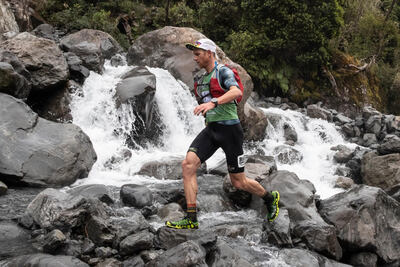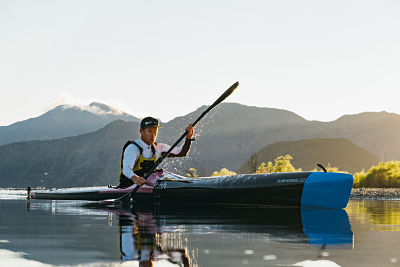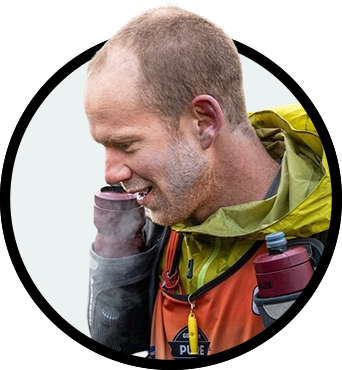The majority of endurance sports are individual pursuits, with the exception of adventure racing and some forms of cycle racing. As a result, we endurance athletes are generally pretty comfortable in our own company as we get used to the solitude and having nothing but our own brains and the whir of the indoor trainer for company during training.
However, training alone all of the time can draw heavily on the intrinsic resources that sustain our motivation to grind away for days, weeks and months on end. Many runners, cyclists, triathletes, and endurance competitors will often choose to train with others, even if each member of the training party has a different goal or desired purpose for the session.

Training with others can offer accountability and incentive to show up and get the job done when scheduled. Strava’s Year In Sport 2022 survey showed that athletes who exercised in pairs or groups went longer and further than when they trained solo.
There are also social benefits as the company can offer a welcome distraction from the session itself, whilst it can also help us connect with social circles that we might otherwise miss out on when juggling a busy training schedule with work and family commitments. Friday nights at the pub are often replaced by training or recovery windows, so the training itself can offer a social escape when Friday nights just ain’t what they used to be!
So how can we share in the company of others while staying on track ourselves? Is it possible to continue or even enhance our progress towards our own goals while training with partners who may have differing levels of ability, ambition or intent?
I would certainly suggest it is, though some considered thought needs to go into deciding who makes the grade as your training partner…
1. Open-minded
Sports science has taught us a lot about training methodologies over the years, but it has also shown us that there’s ‘more than one way to skin a cat’. In case you haven’t heard the saying and currently find yourself with a horrifying image of a cat being skinned, let me expand a little.
When it comes to training towards endurance events and goals, it’s rare that there’s one right way to go about things and everything else is wrong. Many of the athletes I have raced against and coached over the years will bring a different type of training and preparation into the same event. This is because we all have different backgrounds, genetic makeups, injury histories, dietary approaches, work schedules, cultural beliefs; the list really is endless.
I believe the best type of training partners will be open-minded to you doing things your way even if it’s different to how they do them. You don’t need to train with someone who lectures you every session on how they’re right and you’re wrong. You want to train with someone who embraces the difference in training methods, continues to learn and develop, and is happy to train together, even when the session structure itself needs divergence to allow individual variations to occur.
An example is when I’ve cycled with a training partner who has intervals when I don’t. We warm up together and gossip like school children, then he pulls ahead on his intervals before lapping back on his recoveries to keep tabs on where I am. Once the intervals are done, we go back to solving the problems of the world during the cool-down.
2. Harness the ego
We all have a hint of competitiveness in us, which is part of why we choose to challenge ourselves in endurance sport. But the best training partner is the one who can flick this switch on or off to align with the appropriateness of the session. An example would be the long endurance run, often done at a comfortable ‘conversation’ pace.
It’s best to agree on what constitutes an appropriate pace before the first few steps are taken because it can be easy to let the pace creep up, either on purpose or unintentionally.
Choose a training partner for these sessions who has a commitment to the training outcome and session plan, rather than a desire to use the session to make a statement (leave the statements for race day!). I’ve also experienced this in an interval running session when my training partner was simply faster than me. I had a choice between sticking to my own plan and getting left behind or let my ego take over, push harder than my coach had planned and try to keep up.
Remember, it doesn’t matter if you’re faster or slower than your training partner in each scenario, it’s important to choose company that fosters your ability to execute the session in a way that aligns with YOUR training plan.
3. Positive vibes
I’d be lying if I claimed to have a positive attitude to every session, all year round. Endurance sports are hard, tiring and can force us into some fatigue holes that can take a bit of colour out of the world at times.
You’re allowed to vent frustration, sadness and disappointment along the way and sometimes this can be a benefit in sharing sessions with training partners. But be careful not to surround yourself with partners who spend too long venting.
In the end, we should be choosing a training lifestyle that is enriching and brings us happiness and fulfilment too. If you find your training sessions are becoming like a counselling session on every occasion, it could be a sign you need to refresh your training partnerships.
Make sure you’re training with people who bring the positive vibes too. Perhaps a bit of yahooing and high fives upon completion of a session, some joking around and playful approaches when suitable, and an ability to laugh at yourself and each other along the way.
Having fun and achieving key performance goals and milestones don’t have to be mutually exclusive.
4. The hammer and nail
Some days you’re the hammer, other days you’re the nail. I have often needed my training partner to show up just to help get me through a session I might not have completed on my own.
I remember doing a key long run one Sunday a couple of weeks before an IRONMAN. It was raining, it was cold, and the idea of running 25km just didn’t appeal. I texted my friend and begged him to join me. He had no reason to come but chose to because he wanted to help me out.
He got me through that key run and a few months later he asked me to join him for a swim set. He had a long swim to do and was knackered from training that week. He simply didn’t have the motivation to head to the pool alone on that day. Admittedly he was a faster swimmer than me, but I threw on the pull buoy and paddles to ensure I didn’t get left behind, jumped on his feet and hung on for dear life.
Whether your training partnership on a given day resembles benevolence or self-centredness, the best kind of training partners are the ones willing to share the roles of both 'hammer' and 'nail'.
5. Mixed abilities...
It’s worth acknowledging that finding a training partner with identical abilities, strengths and weaknesses is nearly impossible.
The challenge is to find ways where each person might move at different speeds and therefore separate within the session. Separation is OK. We don’t need to be side-by-side to still draw extra energy from the presence of our training partners.
Consider a swim squad environment. You might have faster and slower swimmers in the adjacent lanes, but you’re still feeding off the presence of those around you.
I’ve done a lot of kayak sessions where my training partner isn’t as fast during the 1km repeats, yet I’m logging faster times for that 1km compared to if I’d done them alone. I still sense a competitiveness knowing they won’t want me to get ‘too far ahead’ and I’m energised by the thought that I’m trying to pull away by as much as I can!

I’ve also found myself in scenarios where my training partner is faster than me. We can either see this as a threat to our own performance and mindset or something that helps us aim a little higher and push a little further.
Just this week I watched a training partner surpass my personal 20-minute FTP score (maximal 20-minute power on a bike) and felt instantly inspired to take my own performance up a notch at the next opportunity.
In the end, our goal should be to do our own personal best and when you have a good training partner and the right attitude, you can always find ways to continue to be your best in their presence.
While some of us will choose to train mostly alone, there’s always a place for training with others at certain stages in a week or a season. I hope some of the tips above help you identify the right types of people to spend your time with in training.
If nothing else, these suggestions might offer you a chance to reflect on your own attitudes in group training settings and whether there are ways you might look to improve on what you bring to training sessions and the people around you.
